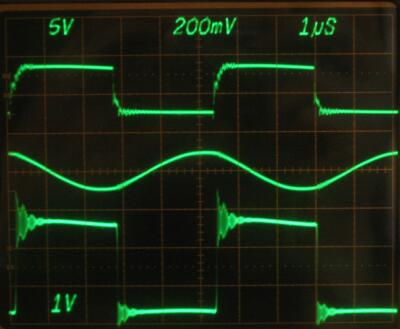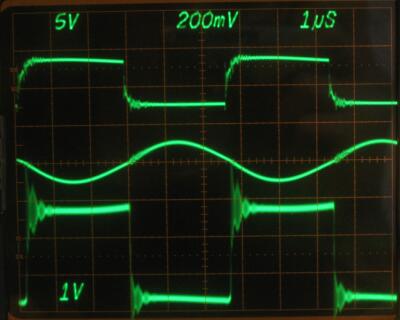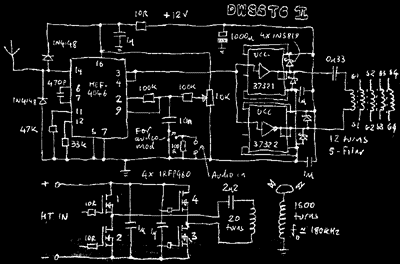

I had heard of many people trying to run a PLL and failing. So that made me all the more eager to try it.
Firstly, it is self-tuning like the antenna feedback circuit, but self-starting like an oscillator. (The VCO is always running.) So it's like one of the combined antenna/oscillator circuits that have been popular lately, except the changeover from oscillator to antenna is always smooth.
Secondly, it allows adjustment of the phase angle, so you can have your MOSFETs switching exactly on the primary current zeros, or even a little BEFORE them. The antenna circuit is limited to switching slightly after the zeros.
Don't believe me, well check it out ;) These traces were taken from the PLL-DWSSTC running at 50V, 4.5A input and producing a 2" jet of corona. Top trace is gate voltage of one MOSFET, middle trace is primary current, bottom trace is output voltage of one side of the bridge.



What's so impressive about that I hear you say... You can do that with an oscillator... Well, once you've set the phase angle for cleanest switching, the PLL will keep it there as the resonator is detuned by corona loading.
Thirdly, it can be designed not to lock onto signals that are outside the range your inverter can handle safely.
Fourthly, it's simple (one chip) pretty cheap (chip cost me 0.60 GBP) and it's not really THAT hard to set up...
After mucho fiddling, I found that the type-I phase detector seemed to work best. (I think the type-II is _too_ sensitive for this application.)

Here is the schematic of the circuit I'm now using. It's no different to a normal feedback SSTC, except for the 4046 in place of the comparator, and the lack of bypass/isolation diodes in the bridge. I'm hoping the PLL will keep the switching near enough zero current that they won't be needed.
ARG! Bug Alert! There is a mistake in this schematic (pointed out to me by the kind folks at 4hv.org)
The 4046 chip would appear to have two pin 7s! The real pin 7 is the one connected to the 470pF cap. The one that is grounded should actually be pin 8.
The unclear pin number near the top of the chip is "16"
The enable pins on the UCC37321/37322 should be connected to +12v. They will work with the pins left floating but may pick up interference.
Update (Jan 2005) I developed this circuit, adding a wider adjustment range and an interrupter. In this form I successfully used it with a DRSSTC, an induction heater and a flyback. It's still under development and should soon have the power to drive 600A IGBT bricks!
Next step is to wire it all up, and dial in the phase. This is pie if you've got an oscilloscope, just look for the setting that gives minimum crud and ringing on your waveforms.
If not, run the bridge off a lower voltage, to save killing the MOSFETs until you get it right. Start with the 10K pot fully clockwise (to top of page) and turn it anticlockwise until your Tesla coil output reaches a maximum. Then turn it back a hair.
Another good way I found of setting it is to run off halfwave rectified mains (maybe with a variac at 50%) and turn the pot anticlockwise until you get breakout. Keep turning it until the sound of the discharge gets harsh and edgy (like BZZZZ instead of Hummm... Hissss) then turn it back until the harshness goes away.
